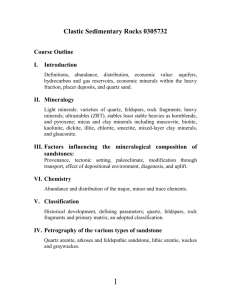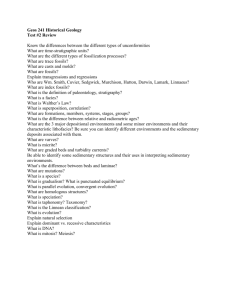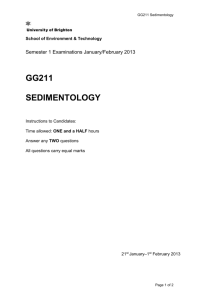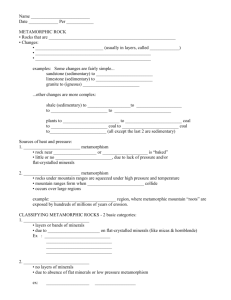Petrology of sedimentery rocks
advertisement
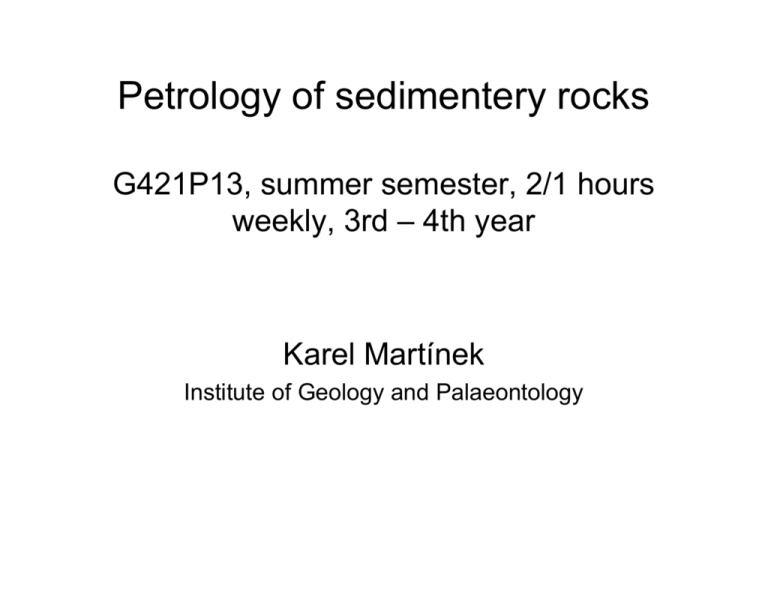
Petrology of sedimentery rocks G421P13, summer semester, 2/1 hours weekly, 3rd – 4th year Karel Martínek Institute of Geology and Palaeontology syllabus Lectures 1. Siliciclastic sediments – granulometric analysis, provenance and geotectonic position Æ modal composition, heavy minerals – classification – see 1st year course Introduction to petrology of sedimentary rocks – sedimentary environments and facies - see course Sedimentary geology (2nd year) – diagenesis: compaction, porosity, authigenesis, cement types, diagenetic environments 2. Carbonates I. – mineralogy, specific sedimentary structures, grain types (Folk 1962), structural classification (Dunham 1962), sedimentary environments 3. Carbonates II. – dolomitization, dedolomitization, porosity changes, early vs. late diagenesis, cement types, diagenetic environments 4. Evaporites, cherts, ferolites, black shales, coal, oil, glauconite, phosphates 5. Cyclicity in sedimentary record, Milankovič orbital cycles, palaeoclimatology 6. Paleosols (humid, semiarid, arid; calcretes, silcretes, dolocretes); Geochemistry of sedimentary rocks (stable isotopes, trace elements, chemostratigraphy, eventstratigraphy, paleoenvironmental changes; cathode luminiscence .....) practicals • fieldwork – facies analysis (measured section of carbonate or siliciclastic section), ½ day • microscopy lab of samples from studied section, 2x ½ day course work • facies analysis (2-3 pages report) of studied section ____________________________________________ requirements to pass the course: oral presentation of scientific paper, fieldwork + microscopy protocols + course work report exam: test – quiz (30 mins) + essay (1-2 hours) 1. Siliciclastics primary structures and composition grainsize and granulometry, sorting, skewness quantitative methods, image analysis, sediment dispersal pathways classification – see 1st year introductory course; arenite, ortho- , paraconglomerate sedimentary structures – see 1st year introductory course and course Sedimentary geology 2nd year phi = -log2D phi: 0.25 0.5 1 2 3 4 D [mm]: 2 1 0.5 0.25 0.125 0.067 grain size sorting vs. mineralogical sorting (mineralogical maturity) grain shapes microstructures provenance analysis modal composition - climate, geotectonic position, unroofing history; heavy mineral association vs. accesoric minerals of source rocks: influence of climate, hydrodynamics and associated processes methods: • detailed mineralogy/chemistry of heavy minerals (garnets, turmalines, pyroxens) • zircon geochronology, apatite fission-track analysis – thermal/tectonosedimentary history • claystone provenance – trace minerals, geochronology total monocrystalline L+Qpolycryst. b, d – oc. basalt a, d, e, f – volc. arc basalt c, d, f, g – within-plate alkali basalts d, e – within-plate tholeiites diagenesis • • • • • geothermal gradient, thermal models porosity, permeability pressure solution, secondary porosity compaction cements - quartz (syntaxial overgrowths, ..), carbonate, authigenic feldspars (overgrowths), clay minerals, zeolites, haematite, barite • diagenetic environments • clay mineral crystalinity the effect of intra-plate stresses onfluid flow in sedimentary basins van Baten&Cloeting 1994 Reading: • M.E.Tucker: Sedimentary petrology. 3rd ed. Blackwell, 2001, 2003. • Prothero: Interpreting stratigraphic record, 1990. • Pettijohn F.J., Potter P.E. a Siever R. (1987): Sand and Sandstone. Springer-Verlag, New York, 553 pp. • Chamley H. (1989): Clay Sedimentology. Springer-Verlag, Berlin, 623 pp. • Potter P.E., Maynard J.B. a Pryor W.A. (1980): Sedimentology of Shale. Springer-Verlag, Berlin, 270 pp.

